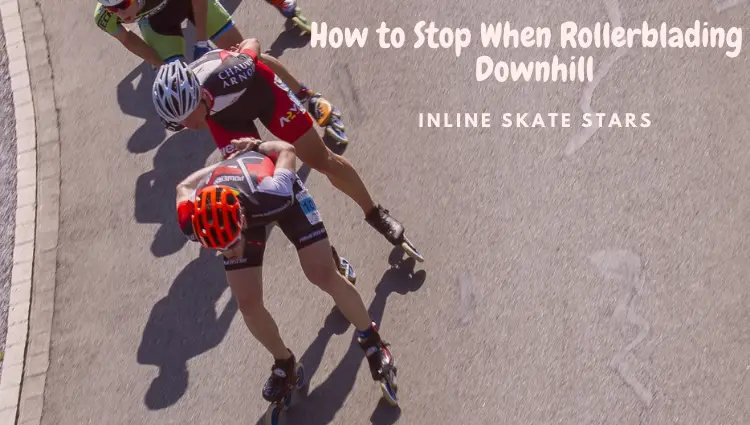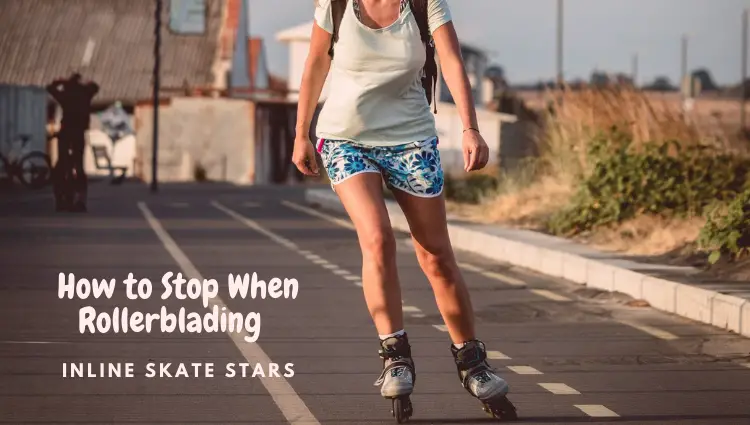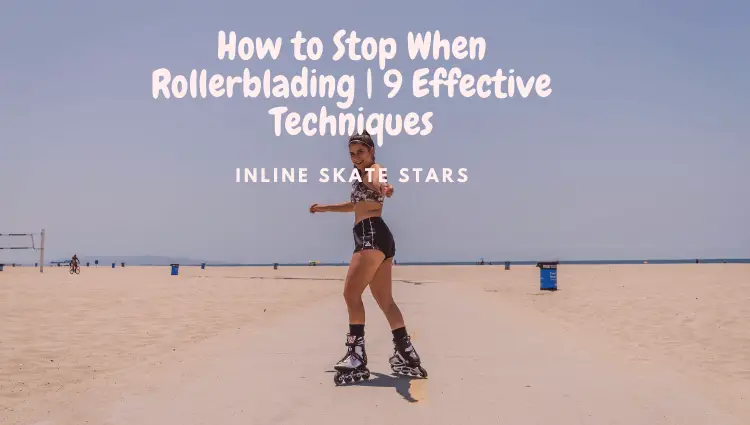How to stop rollerblading at a glance:
Here’s the quick rundown of how to stop rollerblading for beginners, intermediate and experienced skaters.
- Rubber Braking—Best for beginner skaters.
- Fish Braking—Best for intermediate skaters.
- T-stop Braking—Best for when rollerblading downhill.
- Power slide Braking—Best emergency braking for intermediate and advanced skaters
- Snow plow Braking—Best for intermediate skaters
- Soul Slide Braking—Best for advanced skaters.
- Magic Slide Braking—Best for advanced skaters.
- Parallel Slide Braking—Best for advanced skaters, and
- Falling Down—Best for beginners.

How to stop when rollerblading is crucial for your safety, whether you’re a complete beginner, an intermediate skater or a pro skater. Therefore, mastering several skating techniques can save you when rollerblading fast or rollerblading downhill.
Plus, with the right stopping techniques, you can learn to brake with or without brakes. So, what’s the right way (s) to brake? You could be wondering. The best braking technique is easy to learn and apply and effectively keeps you safe while on the roads or at a skate park.
Today, that’s what you’ll discover in this guide: how to stop when rollerblading. I’ve put together this write-up from personal experience and consultation with other expert skaters. I believe you’ll find this guide helpful. So, let’s get to it!
1. Rubber Braking—Best for Beginner Skaters
Some inline skates come with an in-built braking system. This braking system is a plastic extension with rubber material found on the right rollerblade skate for most skates.
Most importantly, this is the most beginner-friendly braking technique and works well when the surface is relatively rough.
Unfortunately, the braking is more suitable for straight-line braking, meaning it’s less effective when braking around corners and bends.
So, how should you go about this braking technique? You could be wondering.
- While in the bent-knee position, bring the foot with the brake slightly forward.
- Raise your toes off the ground to lift the skating shoes while the heel section is on the ground.
- Put your hands on your knees, the one with the braking pad and apply pressure to come to a stop (though putting your hands on your knees is optional).
There you have it. However, rubber braking may not work effectively for emergency braking.
2. Fish Braking— Best for intermediate skaters
Fish braking is suitable for slowing down when rollerblading downhill, and it works best on the road with a wide width. Besides, it’s simple to learn and apply while rollerblading and is excellent for beginners and intermediate skaters.
Below is how to slow down and bring yourself to a stop using the Fish braking technique;
- While in the bent-knee position, bring one foot few (3) inches in front of the other.
- Alternate skating movements from one side of the road to the other to slow down your acceleration speed.
- Do this until you can come to a complete stop.
- For a quick stop, the road should be wide enough.
The main downside to this technique is the wearing out of wheels. Therefore, you may have to replace your wheels occasionally.
3. T-stop Braking—Best for when Rollerblading Downhill
T-stop braking is more popular amongst skaters and works well when rollerblading downhill or on flat terrain. The best part is, it’s easy to learn and apply. Plus, it doesn’t require much space.
Besides, you can rely on the technique to stop on bends and straight lines. This makes it versatile for all skaters, regardless of the level of skating.
However, for complete beginners, the technique may take a while to master. The main downside is how fast the technique wears out your wheels.
Also, the technique may not work on smooth or wet surfaces. To get started, you can train yourself to stop on one foot, then graduate to the other when you’ve got complete control of your body and legs.
Below is how to stop rollerblading using the T-stop braking technique;
- Master your balance by rollerblading on one skate while the other foot is in the air and in T shape. Switch to the other foot when you’re comfortable going on one foot.
- While in the bent-knee position, lift one foot a few inches into the air to make a T-shape with the foot that’s on the ground.
- Gently bring the foot to rest while dragging it on the surface. You should maintain the T-shape while applying pressure on the other foot.
- For instant braking, apply more pressure on both feet.
4. Power Slide Braking —Best Emergency Braking for Advanced Skaters
Power slide braking involves turning in the opposite direction to face the direction you’re coming from while sliding one foot until you come to a stop.
The technique takes a while to master and may potentially wear your wheels out. Before getting to the power slide, you need to have mastered T-stop braking.
Below is how to stop rollerblading using the Power Slide braking technique;
- While in the bent-knee position, make a 180 degrees turn and face the direction you’re coming from.
- One foot should remain bent at 90 degrees angle, while the other should be straight and inclined at an angle of around 30 degrees with the surface.
- Slide this leg on the surface while in motion to slow down, then lift yourself and the sliding foot to an upright position.
5. Snow Plow Braking— Best for intermediate skaters
The snow plow braking works well on dry, wet, smooth and rough surfaces. It’s easy to learn and to apply when skating downhill or flat terrains. Most importantly, it’s gentle on wheels, meaning it doesn’t speed up wearing out.
Therefore, this helps you save tons of money in the long run. The snow plow braking technique is slightly advanced but still beginner-friendly. The best part is, even intermediate skaters can rely on this technique to come to a stop when rollerblading.
Below is how to stop rollerblading using the snow plow braking technique;
- While in the bent-knee position, push your skates and legs outwards in V shape while the skates are in outside edges.
- Remember to curve your legs as you bring them inwards, with the toes pointing each other to come to a stop. For instant braking, make a broad outward curve.
6. Soul Slide Braking— Best for advanced skaters
Souls Slide braking technique is advanced and more suitable for intermediate and more advanced skaters. One needs to master complete body balance and other basic braking techniques like t-stop and power slide to get on Soul slide braking.
The technique is effective and reliable for quick instant braking when rollerblading downhill or on a flat surface. Besides, it works for all types of surfaces—smooth, rough, dry and wet.
Unfortunately, it quickly wears out your wheels. Therefore, you may need to have a budget for regular wheels replacement.
Below is how to stop rollerblading using the Soul Slide braking technique;
- While in the bent-knee position, decide the support foot and the sliding foot.
- The support foot should maintain an upright and 90 degrees position.
- Move the sliding foot outward and inwards in a scissor position. For better results, the outward movement should cover a considerable long-distance and curve.
- Bring the sliding foot in front of the support foot while it’s making contact with the ground at 45 degrees.
- Apply pressure on both legs until you come to a stop.
7. Magic Slide Braking— Best for advanced skaters
The magic slide is more advanced and almost the same as the power slide with slight variations. This technique works well on rough and dry surfaces since it involves sliding your feet. However, it’s more suitable for advanced skaters.
The main downside is the wearing of wheels after a while. If you’re looking for an effective emergency braking technique, the Magic slide braking would be a good fit.
Below is how to stop rollerblading using the Magic Slide braking technique;
- While in the bent-knee position, decide the support foot and the lead sliding foot.
- Slightly bend to the support foot to inwards.
- Quickly bring the sliding foot in front while keeping most of the weight on the support foot.
- Slide both feet until you come to a stop.
8. Parallel Slide Braking— Best for advanced skaters
The parallel slide braking is quite advanced, meaning it’s best suited for pro skaters. Besides, it works on multiple surface types, including; smooth, rough, wet and dry surfaces. Nonetheless, you may slide for a little longer on smooth and wet surfaces before coming to a stop.
The main downside is that it wears out wheels. Below is how to stop rollerblading using the Parallel Slide braking technique;
- While in the bent-knee position, decide the support foot and the lead sliding foot.
- Make a sharp bend while rolling on your skates at an incline angle. Keep the wheels positioned on the edges, i.e. inside edges for the sliding foot and outside edges for the support foot.
- Slightly curve the back foot—slide foot—while applying enough pressure on both heels until you come to a stop.
9. Falling Down—Best for beginners
Falling down works well for complete beginners. Without any other braking technique, the last option to resort to is falling. However, for your safety, try falling on soft surfaces like grass.
Also, make sure you’ve got protection on—helmet, elbow pads, and kneepads—before thinking of falling.
Please check out these cool helmets for Rollerblading on Amazon
S1 Lifer Helmet for Biking, Skateboarding, and Roller Skating
S-ONE S1 Lifer Helmet for Biking, Skateboarding, and Roller Skating
Triple Eight THE Certified Sweatsaver Helmet for Skateboarding, BMX, and Roller Skating
Pro-Tec Full Cut Certified Skate Helmet
Please check out these cool Wrist Guards for Rollerblading on Amazon
How to Stop Rollerblades: Frequently Asked Questions

1. Do roller hockey skates have brakes?
Roller hockey skates have no in-built brakes. A braking system like the heel rubber brake can get in the way while playing hockey. Because of this, the manufacturers would rather not have brakes on roller hockey skates. Nonetheless, there are advanced braking techniques like the T-stop that hockey players can use.
2. Can you add brakes to rollerblades?
Adding brakes to your rollerblades is possible and a pretty simply DIY thing. But still, you can take your skates to your rollerblade skates store of choice and have them fixed by a professional. All you need for this are new rubber brakes and an Allen key for screwing out the old brakes and fixing the new one.
3. Do you need brakes on rollerblades?
You need brakes on your rollerblades when you’re a complete beginner or intermediate skater. The inbuilt brakes are suitable for novice skaters who are learning how to skate and can use the heel rubber brake to come to a stop when rollerblading.
However, for some intermediate skaters and advanced skaters, the in-built brake system is of no use. This is because there are numerous other braking techniques such as T-stop, Fish braking, power slide braking, snowplough braking, soul slide braking, magic slide braking and many more.
How to Stop Rollerblading: Final Thoughts

There you have it: 9 effective braking techniques for beginners, intermediate and advanced skaters. Skating is a fun sport, but when your safety is compromised, it beats the logic. If you’re starting, practice the rubber braking techniques since it’s best for beginners.
If you’re an intermediate skater, you can try various braking techniques like snow plow braking. For experienced pro skaters, there’s really no limit to what you can try. However, a more advanced braking technique that would suit your level is power slide braking.
At a glance, here’s the summary of the best, most effective braking techniques for rollerblading.
- Rubber Braking—Best for beginner skaters.
- Fish Braking—Best for intermediate skaters.
- T-stop Braking—Best for when rollerblading downhill.
- Power slide Braking—best emergency braking for intermediate and advanced skaters
- Snow plow Braking—best for intermediate skaters
- Soul Slide Braking—Best for advanced skaters.
- Magic Slide Braking—Best for advanced skaters.
- Parallel Slide Braking—Best for advanced skaters, and
- Falling Down—Best for beginners.
Cheers mate!
Related posts
Rollerblading Vs. Roller skating | the Definitive Comparison
Rollerblading Vs. Running | the Ultimate Comparison
10 Health Benefits of Rollerblading | New Research


